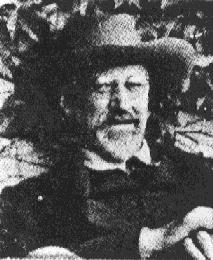| . |
 |
. | ||
| Department of Literature | ||||
 |
...
|
|
||
| . |
 |
. | ||
| Department of Literature | ||||
 |
...
|
|
||
| BIO |
by Donald Clarke
One of the members asked if we could give a little background on this author who so influenced young Howard P. Lovecraft.Edward John Moreton Drax Plunkett, 18th Baron Dunsany, was born on July 24, 1878 at Dunsany Castle, County Meath, Ireland. His uncle was the statesman Sir Horace Plunkett who first proposed the Dominion structure for the creation of the Irish Free State. Dunsany's youth was spent with his mother's ancestral estate, Dunstall Priory, Shoreham, Kent, England. He attended private schools: Cheam School and Eton and completed his education at the military college at Sandhurst. When the Boer War broke out in 1899, Dunsany fought in the Coldstream guards. That same year he acceded to his title of Baron. In 1904 Dunsany married Lady Beatrice Villiers, youngest daughter of the 7th Earl of Jersey, and has one son, the Hon. Randal Plunkett, born in 1906. When World War I broke out, Dunsany was a Captain of the Royal Inniskilling Fusiliers. At a very tall six feet, four inches, he remarked that: "Our trenches were only six feet deep. I shall never fear 'publicity' again." He was wounded April 25, 1916 but survived the war to continue his illustrious career. With Dunsany's death in 1957, his son Randal became the 19th Baron Dunsany. Though Lord Dunsany had an interesting military and political career, it his writing which he is best remembered for. Much like Lovecraft, his youth was spent in fantasy. In a letter to Frank Harris, Dunsany wrote: "I think I owe most of my style to the reports of proceedings in the divorce court; were it not for these my mother might have allowed me to read newspapers before I went to school; as it was she never did. I began reading Grimm and Andersen. I remember reading them in the evening with twilight coming on. All the windows of rooms I used in the house in Kent were I was brought up faced the sunset. . . . When I went to Cheam School I was given a lot of the Bible to read. This turned my thoughts eastward. For years no style seemed to me natural but that of the Bible and I feared that I never would become a writer when I saw that other people did not use it. When I learned Greek at Cheam and heard of other gods a great pity came on me for those beautiful marble people that had become forsaken and this mood has never quite left me." In 1905 he published Gods of Pergana. In it, Dunsany incorporated the form of classical mythology into a world of his own making. Based on its success, he produced a string of similar tales which were published under the titles: Time and the Gods (1906), The Sword of Welleran (1908), and A Dreamer's Tales (1910). These volumes were usually illustrated by Sidney H. Sime, an artist who also much impressed Lovecraft and is often mentioned in Lovecraft's stories. Of Dunsany's fantastic imagination Lovecraft wrote: "Dunsany is the greatest of the name-coiners, and he seems to have three distinct models-the Oriental (either Assyrian or Babylonian, or Hebrew from the Bible), the classical (from Homer mostly), and the Celtic (from the Arthurian cycle, etc.). Thus he invents Eastern-sounding words like "gyshaw", "Sardathrion", "Bethmoora", etc. Hellenistic terms like "Argimenes", "Poltarnees", etc., and pseudo-Celtic names like "Arleon" and "Carmorak". I myself sometimes follow Dunsany's plan . . . " [1] In 1909, Dunsany wrote his first play, The Glittering Gate, at the request of W. B. Yeats. Its success at the Abbey Theatre in Dublin prompted Dunsany to produce a long list of plays which were successfully staged from Moscow and the United States. While his chief interests were in writing of plays and tales, he managed to add the 1929 Fifty Poems to his bibliography. While Lovecraft admired the plays, it was the fantasy stories which impressed Lovecraft most. He says in "Lord Dunsany and His Work": "We here find the best Dunsanian forms fully developed; the Hellenic sense of conflict and fatality, the magnificently cosmic point of view, the superbly lyrical flow of language, the Oriental splendour of colouring and imagery, the titanic fertility and ingenuity of imagination, the mythical glamour of fabulous lands 'beyond the East' or 'at the edge of the world,' and the amazing facility for devising musical, alluring, and wonder-making proper names, personal and geographical, on classical and Oriental models. Some of Dunsany's tales deal with the objective world we know, and of strange wonders therein; but the best of them are about lands conceivable only in purple dream. These are fashioned in that purely decorative spirit which means the highest art, having no visible moral or didactic element save such quaint allegory as may inhere in the type of legendary lore to which they belong. Dunsany's only didactic idea is an artist's hatred of the ugly, the stupid, and the commonplace. We see it occasionally in touches of satire on social institutions, and bits of lamentation over the pollution of Nature by grimy cities and hideous advertising signs. Of all human institutions, the billboard is most violently abhorrent to Lord Dunsany." [2] In 1919 Lovecraft went to Boston with other amateur journalists to hear Dunsany speak: "Arriving early at the Copley-Plaza, we obtained front seats; so that during the address I sat directly opposite the speaker, not ten feet from him. Dunsany entered late, accompanied and introduced by Prof. George Baker of Harvard. He is of Galpinian build--6 ft. 2 in. in height, and very slender. His face is fair and pleasing, though marred by a slight mustache. In manner he is boyish and a trifle awkward; and his smile is winning and infectious. His hair is light brown. His voice is mellow and cultivated, and very clearly British. He pronounces were as wair, etc. Dunsany first touched upon his ideals and methods; then hitched a chair up to his reading table, seated himself, and commenced reading his short play, The Queen's Enemies. This is based very obviously upon the anecdote of Nitocris in the second book of Herodotus; but Dunsany averred that he had purposely avoided reading details or even learning the names of the characters in the story, for fear his original imaginative work on the play might be hampered or impaired. I advise you to read it for yourself--it is in Plays of Gods and Men, which every well-regulated library has or ought to have on the shelves. Later Dunsany read selections from other works of his, including a masterly burlesque on his own style--Why the Milkman Shudders when he Sees the Dawn. As he read this, he could not repress his own smiles and incipient chuckles! The audience was large, select, and appreciative; and after the lecture Dunsany was encircled by autograph-seekers. Egged on by her aunt, Miss Hamlet almost mustered up courage enough to ask for an autograph . . . For mine own part, I did not seek a signature; for I detest fawning upon the great." [3] Its effect was immediate: "In 1919 I received the greatest literary stimulus I had had since discovering Poe--through my discovery of Dunsany. Under this new influence I began writing voluminously--though much of the stuff was rotten and unduly imitative of my illustrious model." [4] "As you infer, The White Ship is in part influenced by my new Dunsanian studies. There are many highly effective points in Dunsany's style, and any writer of imaginative prose will be better for having read him. . . . Today I go down to obtain the very latest Dunsany book--just published--Unhappy Far-Off Things, which I first saw advertised in the November Atlantic. Recently I read Time and the Gods, which is not only highly interesting but richly philosophical. You surely must read Dunsany--in places his work is pure poetry despite the prose medium." [5]
|
|
|